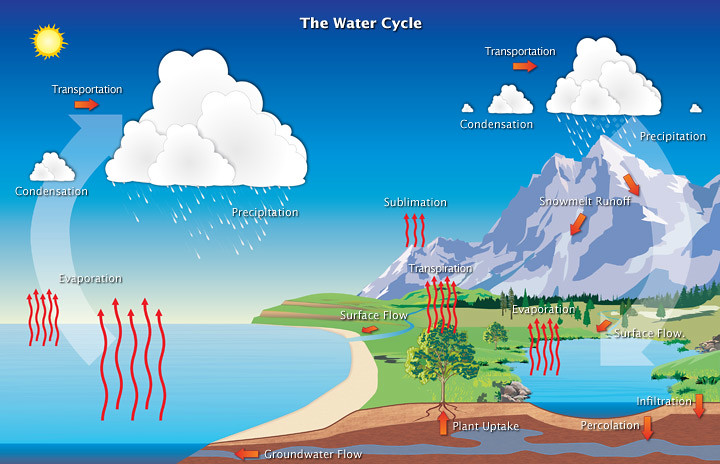 There is a limited amount of water on Earth. It does not stay still in one place or form, but rather, it goes around and around in what is called the water cycle. As it moves around the globe, water can be in different forms: liquid, gaseous or solid.
There is a limited amount of water on Earth. It does not stay still in one place or form, but rather, it goes around and around in what is called the water cycle. As it moves around the globe, water can be in different forms: liquid, gaseous or solid.
The water you see today in a river was previously stored in the soil or deep in the ground before it came out to the surface, forming a spring. That same water will flow downhill until it reaches another river or lake and eventually it will flow into the ocean.
At some point in its history, that same water was taken up by the roots of plants and returned back to the atmosphere in the form of vapor. Along its way around the Earth’s surface, water gets heated up by the sun and turned into vapor, returning to the atmosphere as well. On its way up to the sky, the vapor cools down and condenses, getting stored as a cloud until it falls back to the ground again as snow or rain.
That rainwater or snow eventually goes back into the soil starting the cycle all over again. Think about the many, many times the water you drink today has cycled through the Earth. Oh, the places it has been!
My Research: Eco-hydrology
The research I do belongs to an integrative field of science, named eco-hydrology. It is integrative because it combines two different fields of science to answer big questions that cannot be answered by the methods and concepts of one field alone.
Eco-hydrology integrates the fields of ecology and hydrology. Ecology is the study of how living things interact with their environment. Hydrology, on the other hand, is the study of the Earth’s water cycle and is concerned with finding the solution to water problems that society faces (like, how can we make sure we have clean drinking water?).
So eco-hydrology is the study of how the availability of water modifies ecosystems, and how ecosystems modify the quantity, quality, and movement of water. For example, areas that get very little rainfall will have different plants and animals living there, compared to areas with a lot of rain (this is an example of water modifying an ecosystem).
The trees and shrubs that form a forest have root systems that penetrate the soil and create complex pathways for rainwater and melted snow to enter the soil easily. If that forest is cut, the soil will erode and compact. As a result, the amount of water going into the soil reservoir may be reduced because the root system and all the tiny pores and conduits that it created and helped water go down, might be damaged.
Ecohydrologists try to answer complex and important questions that help us use the limited amount of water more wisely. For example: How much water do different crops use? Which crops are best to grow in a place experiencing drought, such as California? How would the landscape look if the climate changed? What would happen to the water cycle if the rain forest is cut and replaced with a crop like soybeans?







